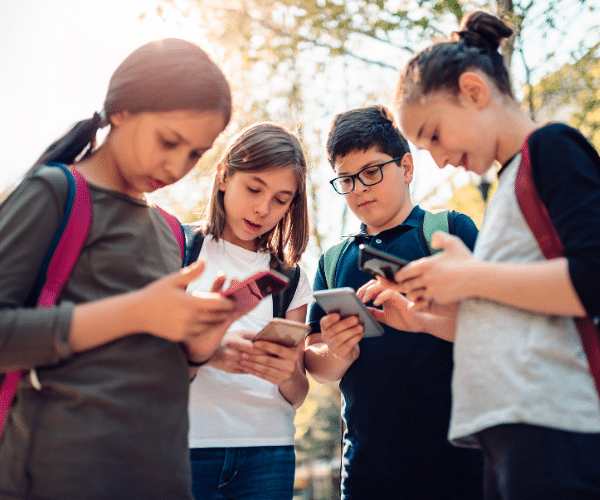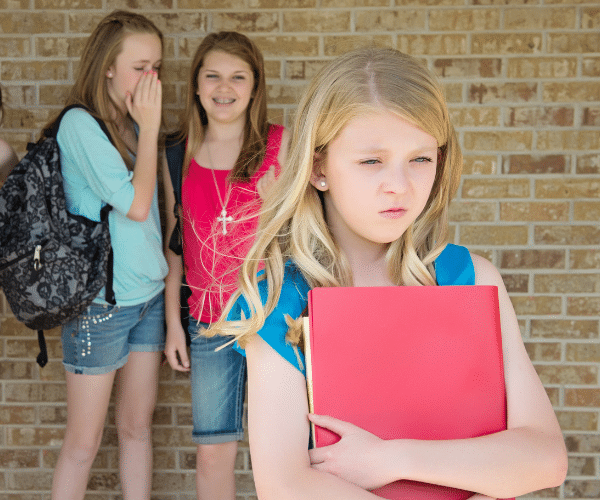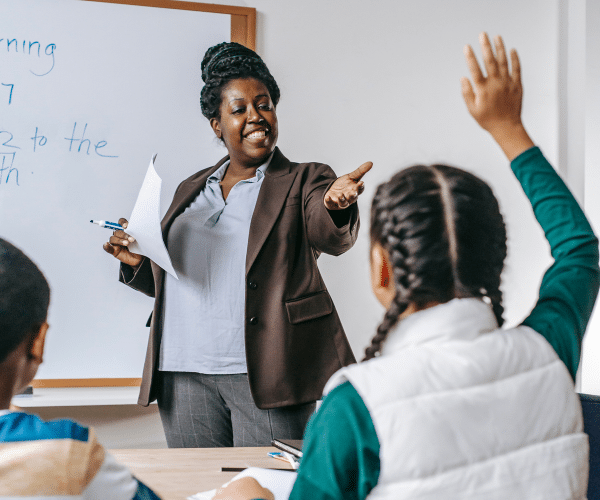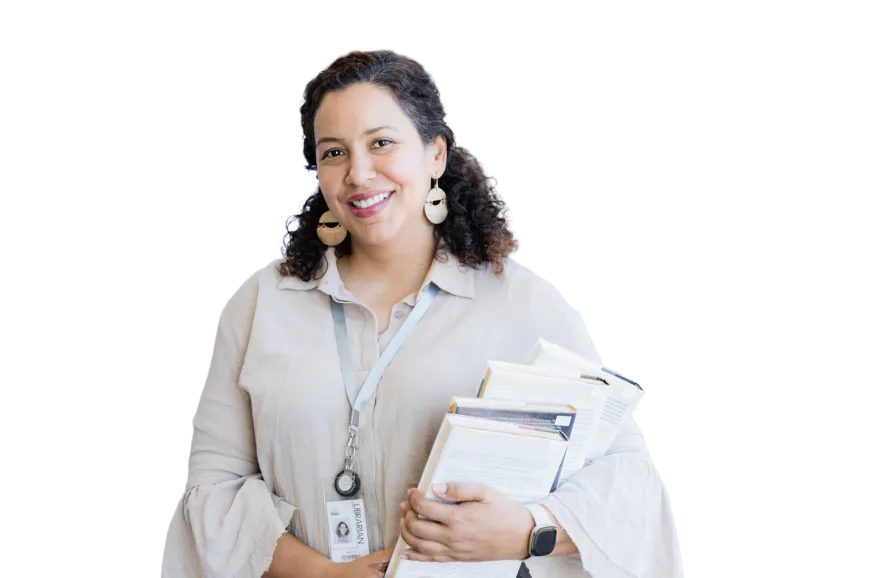October 23, 2023 min read

Supporting Digital Citizenship in K-12 Schools
Industry:
Solution:

Teaching students how to responsibly use social media and stay safe online is a big job. One survey notes 90% of teens ages 13-17 have used social media, and more than half visit a social media site daily. With this high level of usage, and with new social media platforms and trends arising seemingly every day, digital citizenship is becoming more and more important.
What are the best ways for teachers to promote digital citizenship? First, it’s important to understand what digital citizenship is and the challenges and opportunities associated with social media.
Defining Digital Citizenship
In a recent Vector webinar “Navigating the Digital World: Building Digital Citizenship in the Age of TikTok,” digital citizenship expert and Vector course author Dr. Mike Ribble defines digital citizenship as “the continuously developing norms of appropriate, responsible, and empowered technology use.” Being a good digital citizen, he says, means helping others build positive digital experiences, recognizing that one’s actions have consequences on others, and participating in social media in a manner that supports the common good.
In order to help students be good digital citizens, it’s important to understand the potential risks and benefits of social media and to talk about this with students. Ask them why they want to use a particular app or platform and what they see as the benefits. Do they understand the risks? What kind of information will they be sharing and with whom? What are the potential consequences of using this platform or app? Helping students think through their choices about social media and helping them balance how much time they spend on the platforms are important components of digital citizenship.
Social Media Risks
Some of the challenges and risks of social media include:
- Privacy Concerns and Data Security. Too often students hear about an app and jump right into it without knowing the background on the company who developed the app and why they did it. This also brings temptation to immediately share whatever information is being requested without thinking about what is being done with that information.
- Cyberbullying and Online Harassment. A 2021 CDC survey found that nearly 16% of high school students reported being cyberbullied in the past year. The anonymity of social media can make it a haven for this behavior.
- Time Management and Productivity. Students often struggle to break free from their screens which can have a negative impact on their academics, as well as their health.
- Distraction and Lack of Real-World Interaction. Positive online interactions have their place, but it’s important for students to understand these online experiences don’t replace human interaction.
- Inappropriate Content. It can be difficult to monitor what types of content students are being exposed to online. This is of particular concern for younger children.
- Addiction and Mental Health Impact. An estimated 5-10% of Americans meet the criteria for social media addiction – having an uncontrollable urge to use it and spending so much time and effort on it that it negatively impacts other areas of their lives.
Social Media Benefits
Social media also has benefits, including the potential to be used in classroom lessons. For instance:
- Creative Expression: Whether it’s creating a new dance video for TikTok or reciting poetry on YouTube or positive posts on Instagram, social media can be a vehicle for creative expression which is something teachers can also leverage in the classroom through assignments that teach students how to use these platforms in a safe way to promote creative expression.
- Community Building. Social media allows students to expand their circles through online communities – connecting with others who have similar interests. It’s important for students to understand who they are surrounding themselves with and how to do this safely. It’s also important not to substitute online connection with real-world interactions.
- Entertainment and Education. Social media is a primary source of entertainment for many young people and can also be used in education. Social media can also be a way for students (and adults) to identify and pursue entrepreneurial opportunities.
Supporting Digital Citizenship in Schools
In the webinar, Ribble shares several things teachers can keep in mind when supporting digital citizenship in their classrooms. For example:
- Teach students to be civil and to support positive engagement. It’s important for students to remember that there are (usually) real people on the other side of the screen, so they should keep online conversations civil, just as they would in real life.
- Collaborate with students and parents to create a positive and supportive digital environment on all platforms. There are many ways to do this. When all parties are proactive and are working together, it sets the student up for success. Teachers can also share educational information with parents and caregivers on topics surrounding social media platforms and how to have conversations with their children about social media use.
- Teach students about responsible and ethical online behavior. This includes how to keep their own information secure, and how to recognize potential online threats.
- Support media literacy and critical thinking. Teach students how to critically evaluate information they see online. Just because something was posted on SnapChat or Facebook doesn’t mean it’s true.
- Promote cyberbullying awareness and prevention. Teach students how to practice empathy and kindness online and talk about cyberbullying. Understand the signs of cyberbullying and teach students what to do if they witness or are victims of cyberbullying.
- Understand the impact of excessive screen time on mental health and wellbeing and help students to be self-aware of their screen time. If they are up until 2 a.m. playing games or watching TikTok it will affect them physically and mentally the next day.
- Stay Informed. Seek out ways to stay updated about the ever-changing digital landscape. This will help when promoting responsible social media use.
Digital citizenship will continue to become more and more important as the digital world becomes more and more prevalent in the everyday lives of youth and adults. Understanding the pitfalls and the potential of the digital world, proactively teaching digital citizenship in school and partnering with parents and students to support safety, critical thinking and empathy online will go a long way in helping students navigate the digital world successfully.
Digital Citizenship: Practical Tips for Students, Teachers and Parents
Download for practical tips to help students safely and effectively navigate social media.
Download Now
How Vector Solutions Can Help
Vector Solutions provides engaging, expert-authored online courses for educators, administrators and students on a number of important digital citizenship topics.
Staff Courses
Vector’s Safety and Compliance Library includes:
- Digital Citizenship for Administrators
- Digital Citizenship for Elementary Teachers
- Digital Citizenship for Secondary Teachers
Student Courses
Vector’s Healthy Relationships and Inclusion Library for students in grades 6-8 and 9-12includes:
- Bullying and Cyberbullying
- Digital Citizenship
- How to Be an Aware and Positive Contributor Online
- Protecting Yourself and Others Online
- Respecting Yourself and Others Online
- What is Digital Citizenship?
- Why Should You Care About Digital Citizenship?
Navigating the Digital World: Building Digital Citizenship in the Age of TikTok
Free expert webinar with Dr. Mike Ribble
Watch Now
Additional Resources
- Common Sense Media (commonsensemedia.org): Provides age-appropriate ratings, reviews, and resources for parents and educators.
- MediaSmarts (mediasmarts.ca): Offers resources and tools to promote digital and media literacy among students, parents, and educators.
- TikTok Safety Center (https://www.tiktok.com/safety): TikTok’s official safety center, offering tips and guidelines for users and parents.
- Family Online Safety Institute (FOSI) (fosi.org): Provides resources and tips for parents and families.
- National Online Safety (nationalonlinesafety.com): Offers online safety courses and resources for schools and families to promote safe internet usage.
- Digital Driver’s License (https://otis.coe.uky.edu/DDL/launch.php): University of Kentucky digital education resource.
Source: Vector Solutions Webinar with Dr. Mike Ribble: “Navigating the Digital World: Building Digital Citizenship in the Age of TikTok”







